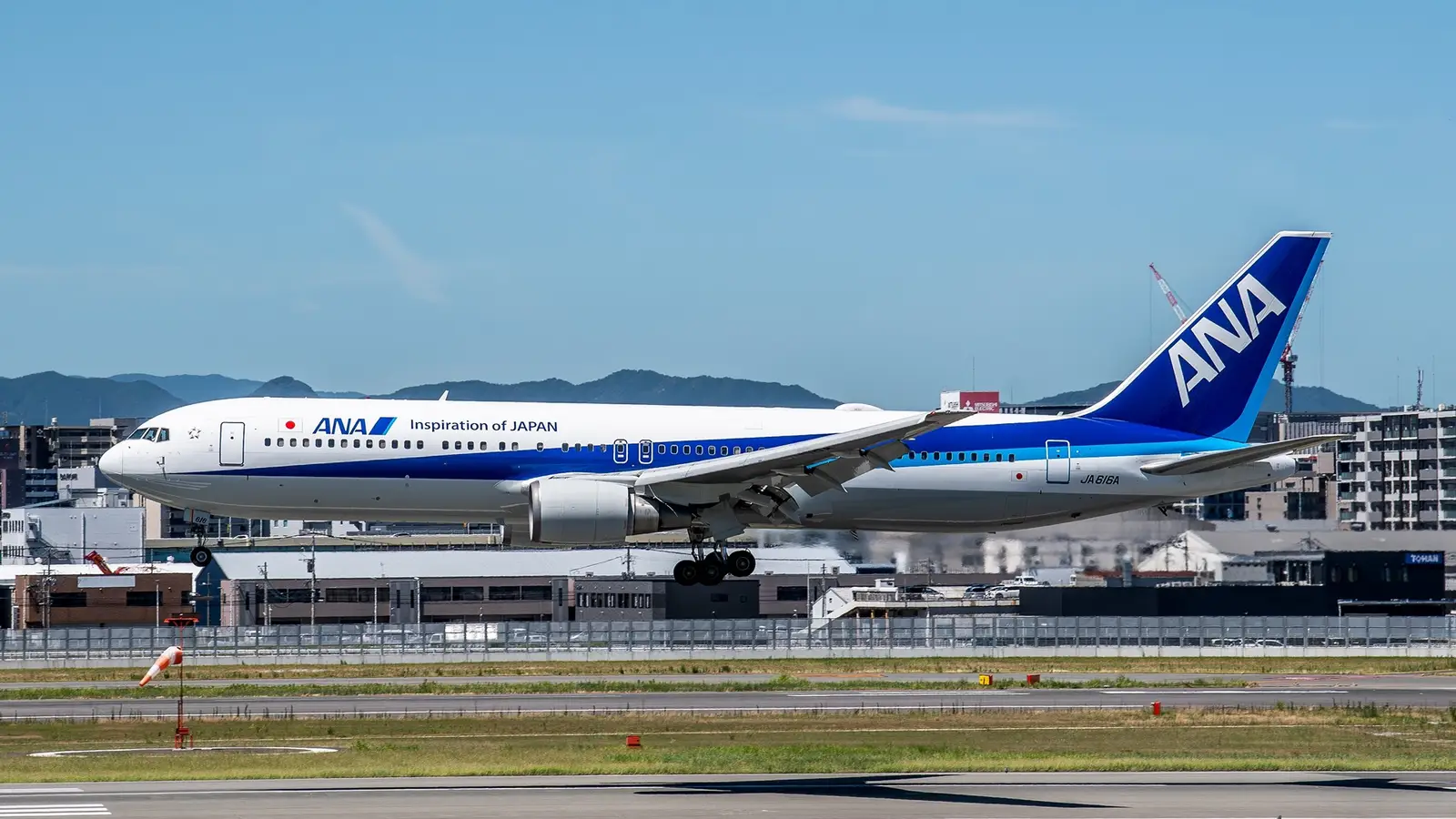
The last passenger outfitted Boeing 767 was delivered in 2011 to All Nippon Airways (ANA), but the global fleet is still going strong, more than a decade after the assembly line shuttered. The 767 is one of the most popular transoceanic widebodies in the world, as one of the most frequently used types to cross the Atlantic on international routes. The 767 was made for a specific market gap in a parallel development program alongside the 757.
Boeing’s 767 was tailor-made for medium-range, high density routes. The aircraft’s range, seating, and payload capacity made it a strong seller when it was launched in 1982. The big jet went on to be increasingly successful over the next two decades, and in the mid-1990s, about 75% of all transatlantic flights were performed by a 767, as KeyAero points out. Today, the same performance, efficiency, and reliability that made it such a rock star of the ‘90’s flying world is keeping the 767 in the game.
Delta Air Lines and United still fly many 767 jets domestically and abroad. Meanwhile, the cargo business has been good for the big jet too. Fedex Express and UPS Airlines have kept the production line open for pure freighter models into the present, with no plans to shut down until at least 2027. Now let’s take a brief trip down memory lane and rediscover the story behind the prolific Boeing jetliner.
Today’s Flying World And The 767
The 767 was the very first widebody twinjet made by Boeing, a class that has now come to dominate the commercial aircraft market. Delta has had over 120 of the 767 series over the past four decades. Today, the iconic airline still flies around 60 of the big jets. Another member of the “big three,” United Airlines has just over 50 in its fleet, according to Planespotters.net data. Meanwhile, JAL (Japan Airlines) and ANA have around 30 and 20 on their flight line, respectively.
The 767’s popularity has given way to the rise of more efficient and higher-capacity twinjets like the Airbus A350 series, 777 series, and upcoming Boeing 777X. That hasn’t made the jet obsolete just yet. The secondhand market makes 767s highly competitive because of their strong performance figures and significantly lower purchase price compared to newer jets. The ease of maintenance and spare parts procurement is also a major selling point for budget-conscious operators. The largest operators, however, Delta and United, simply don’t have a good reason to eliminate the plane when it’s still going strong even in competition with peers that are decades newer.
In the cargo world, the 767 has been a hit practically from day one. The global air cargo network has experienced a meteoric rise alongside the boom in e-commerce since the 1990s. FedEx and UPS fly 150 and 100 freighter models, respectively, as Planespotters.net records. The purpose-built cargo-haulers are still rolling off the line at Boeing’s Everett plant, and hundreds of former-passenger 767 conversions have been delivered to freight flying outfits around the world.
One Mid-Size Model To Rule Them All
An oft-overlooked quality of the 767 is its middle-class dimensions, which is a size that has fallen to the wayside in today’s hunt for ever larger wingspans and turbofans. The wingspan and weight of the 767 allow it to use airfields that are not accessible to 777s, 747s, or the A350. The growing use of composite materials means that newer jets have lower airframe weights, but large wingspans reduce the taxiways, gates, and hangars that can be used.
Most of the world’s large runways are at airports that prioritize passenger traffic because of a combination of higher profit margins and national transportation mandates regarding infrastructure usage. Many large freighters, like the industry-leading 747-8F, fly in and out of mega-hubs at Hartsfield-Jackson Atlanta International Airport (ATL) and Los Angeles International Airport(LAX) every day, but to maximize traffic, cargo carriers need to have as many options as possible, which makes the 767 a valuable tool.
Many carriers can’t afford slots at hubs that accommodate the largest twinjets or don’t have the capital for the planes themselves, creating a continued demand. From the outset, the 767 was meant to occupy this mid-tier slot in the commercial jet market. Today, the 787 Dreamliner has become its successor in the passenger class with the Boeing 737 MAX under it and the as-of-yet uncertified 777X poised to take the crown of Boeing’s biggest widebody as the 747 fades into history.
The Global 767 Fleet In 2025
The number of 767-300s operating around the world was reported to be 666 as of August 2025 by the International Air Transport Association (IATA). The total number of all variants is estimated to be close to 800. That means the aging widebody still represents between 12% and 15% of all widebodies flying today. There may not be any new 767 passenger models coming off the line in the future, but the 80s workhorse is far from finished with its days in the sky.
When ANA ordered nine new 767-300ER jets in 2002, excitement was high for the larger, more comfortable, and high-performing jet. Yoji Ohashi, ANA’s president and CEO, said in the press release:
“Our fleet plans are a clear signal to the competition that we’re going to maintain a position of leadership in the domestic market. These aircraft will increase the company’s flexibility to respond to changing requirements in air transport and are consistent with our goal to be the leader in Asia by providing the most comfort in the sky.”
So far, United has only retired a handful of its 767 and 777 series aircraft as a small number of 787s have joined the fleet. Meanwhile, JAL, ANA, and Delta have all opted into orders for Airbus A350 twinjet widebodies. The Airbus is a smaller but highly efficient competitor to Boeing’s 777X, which is still undergoing certification trials. The A350, on the other hand, has already proven itself through years of active service.
Delta’s 767 Stables
Delta is a major reason why both the 767 and 757 are still flying in the high numbers that they do. The airline has a massive global network, but its bread and butter is the high domestic traffic that flows through its hub at one of the largest airports in the world, Hartsfield–Jackson Atlanta International Airport (ATL). The field is also home to one of the world’s most comprehensive maintenance, repair, and overhaul (MRO) operations on Earth.
Delta’s balanced business model, paired with a highly self-sufficient sustainment apparatus, means that the airline can keep its jet flying with minimal support from its maker. Delta relies on flexible aircraft models that have the performance, capacity, and efficiency to be versatile in terms of deployment as the market and traffic shift. The 767’s size fills an important role in the Delta strategy.
Boeing’s decision to favor only small and large airframes is widely attributed as the reason for higher numbers of Airbus orders in recent years. To date, no airline in the “big three” has ordered a 777X, including Delta, which has already retired all of its 777s. Delta also hasn’t purchased any 787 Dreamliners, instead sticking with its 767s until Airbus A350s can be delivered.
The 767 Backstory
Although it was Boeing’s first widebody twinjet, the 767 wasn’t a solitary design effort. The 757 was developed in parallel with common architecture, components, cockpit layout, and other features. The goal was to make Boeing aircraft more appealing to carriers through reduced training, simpler maintenance and supply chains, which would all combine to save money, plus improve dispatch reliability across the global Boeing fleet of all types.
The 767 wasn’t exactly a direct successor to any one preceding aircraft, but rather a new design intended to fill a gap in the market. Boeing needed a longer-range, more efficient, and more comfortable jet that could bridge the disparity between the 737 and 747. The maker also wanted to compete more directly with rival designs like the Lockheed L-1011 TriStar and McDonnell Douglas DC-10.
The initial concepts for the 767 included T-tail and tri-engine mock-ups, but ultimately Boeing went with what it knew and stuck to the classic twinjet format. The resulting aircraft has far outstripped the three-engined competitors that it went head-to-head with after its debut. The 767 achieved higher sales, greater popularity, and has remained in production long after McDonnell Douglas was absorbed by Boeing and Lockheed stopped making jetliners altogether.



